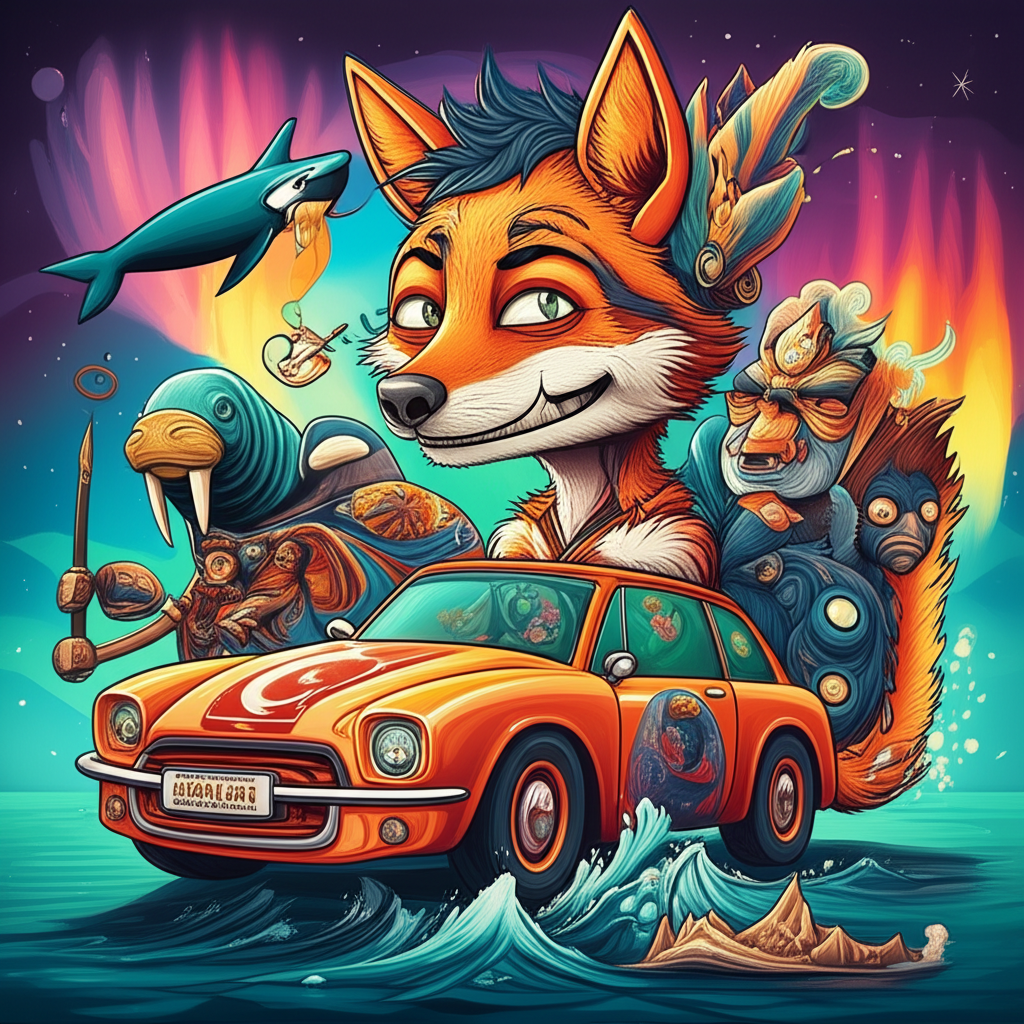
Across the vast, untamed landscapes of North America, where the wind carves stories into ancient stone and the stars paint celestial narratives upon the night sky, lie the roots of countless myths and legends. These are the traditional stories, whispered through generations by the Indigenous peoples of this continent, reflections of their profound connection to the natural world and their attempts to understand its mysteries. Among these captivating tales are those that speak of mischievous spirits, formidable guardians, and the deep, resonant power of the ocean. Today, we journey into a corner of this rich tapestry of folklore, exploring the symbolic figure of the trickster, the elusive Pukwudgie, and the evocative imagery of the Inuit Seas, understanding them not as beliefs, but as fascinating expressions of human imagination and cultural heritage.
The stories we will touch upon emerged from a time when the world was perceived through a lens of animism and interconnectedness. For the ancient peoples of the Northeastern woodlands, where the Pukwudgie lore is often situated, and for the Inuit of the Arctic, life was inextricably linked to the rhythms of nature. Their existence was a constant negotiation with the elements, a deep respect for the power of the wild, and a keen observation of animal behavior, weather patterns, and the subtle shifts in the land. The world was alive with spirits, each playing a role in the grand cosmic dance. These myths served as vital conduits for transmitting knowledge, social norms, and explanations for phenomena that defied immediate comprehension. They were the ancient textbooks of morality, survival, and the very essence of existence.
The concept of the trickster is a potent archetype found in mythologies worldwide. In many Indigenous traditions, the trickster is a complex figure, often embodying duality. They can be a bringer of chaos and confusion, disrupting order and challenging established norms, but paradoxically, they can also be a catalyst for change, a source of innovation, and even a teacher. The trickster’s actions, while seemingly nonsensical or self-serving, often serve a greater purpose, revealing hidden truths or forcing a re-evaluation of the status quo. They are the agents of surprise, the embodiment of the unpredictable, and the reminder that not all power resides in the predictable or the overtly strong.
One such figure, often associated with the trickster archetype in the folklore of the Wampanoag and other Algonquian-speaking tribes of the Northeastern woodlands, is the Pukwudgie. Imagine a creature of diminutive stature, perhaps no taller than a human child, yet possessed of a potent, often unsettling, aura. Their skin might be described as ashen or grey, their forms slender, and their eyes, often depicted as gleaming or sharp, hinting at an ancient, knowing intelligence. They are not benevolent spirits, nor are they purely malevolent. Instead, their nature is capricious, their actions driven by whim and a mischievous spirit. They might appear to offer aid, only to lead travelers astray with illusions, or they might unleash sudden storms or unexpected dangers. Their symbolic attributes lie in their ability to represent the wild, untamed aspects of nature, the sudden shifts in fortune, and the unseen forces that can influence human lives. They are the embodiment of the unpredictable encounter, a reminder that even the familiar can harbor the unexpected.
The narrative of the Pukwudgie is not a single, grand epic, but rather a collection of encounters and observations woven into the fabric of their culture. Picture, if you will, a lone hunter venturing deep into the ancient forests, the scent of pine needles and damp earth filling the air. He moves with quiet reverence, attuned to every rustle of leaves, every snap of a twig. Suddenly, a rustling sound draws his attention, and from behind a moss-covered boulder, a Pukwudgie emerges. Its form is small, yet its presence feels significant. It might beckon with a spindly finger, or perhaps emit a series of strange, chattering sounds. The hunter, wary but not entirely fearful, recognizes the signs. He knows that to engage too directly with such a creature is to invite a dance with uncertainty. The Pukwudgie might lead him on a chase, its laughter echoing through the trees, or it might simply vanish as quickly as it appeared, leaving the hunter to question what he saw and what it might portend. These encounters were not about vanquishing a monster, but about understanding the subtle energies of the world and navigating its inherent unpredictability.
The symbolism inherent in the Pukwudgie lore is multifaceted. They can represent the dangers of the unknown, the allure of temptation that can lead one astray, and the inherent wildness that exists beyond human control. Their trickster nature suggests a force that disrupts complacency, forcing individuals to be more observant, more resourceful, and to question their assumptions. In some interpretations, they might also symbolize the spirits of the forest, the guardians of hidden places, and the ancient, primal forces that predate human settlement.
Parallel to these terrestrial whispers, the Inuit of the Arctic speak of the vast and powerful Inuit Seas, a realm teeming with life and imbued with spiritual significance. Their stories are shaped by the stark beauty of their environment, the immense power of the ocean, and the constant struggle for survival. The sea was not merely a source of sustenance; it was a living entity, home to powerful spirits and creatures that demanded respect. The Nuliajuk (sometimes referred to as the Sedna myth) is a central figure in Inuit cosmology. While not a trickster in the same vein as the Pukwudgie, Nuliajuk embodies a complex power that dictates the availability of marine life. She is often depicted as a sea goddess who controls the animals of the ocean, and her mood and disposition directly impact the success of the Inuit hunters.
The narrative of Nuliajuk, in its various forms, often speaks of her descent into the sea and her transformation into a powerful spirit. She might be cast into the ocean by her father, her fingers becoming the seals, her hair the seaweed. Her anger or sorrow could lead to the scarcity of seals, a dire consequence for a people reliant on them for food, clothing, and shelter. Inuit shamans would often undertake spiritual journeys to appease Nuliajuk, performing rituals and offering prayers to ensure the bounty of the sea. The symbolism here is deeply rooted in the realities of their existence: the ocean’s power, the interconnectedness of all life, and the need for balance and respect to ensure survival. The Inuit Seas, therefore, represent not just a physical body of water, but a spiritual domain where the forces of nature and the spiritual realm converge.
In the modern era, these ancient narratives find new life and interpretation. The Pukwudgie, with its mischievous and somewhat unsettling nature, has found its way into modern literature and popular culture, often portrayed as a creature of folklore or a supernatural antagonist. Its elusiveness and unpredictable nature make it a compelling element in fantasy and horror genres. Similarly, the rich mythology surrounding the Inuit Seas, and figures like Nuliajuk, continues to be explored in anthropological studies, cultural documentaries, and artistic expressions, offering a glimpse into the profound relationship between the Inuit people and their environment. These stories serve as a valuable resource for understanding the diversity of human storytelling and the ways in which different cultures have sought to make sense of their world.
In conclusion, the tales of the Pukwudgie and the evocative imagery of the Inuit Seas are not to be taken as literal truths or divine pronouncements. They are profound expressions of the human imagination, born from the unique experiences and worldviews of ancient peoples. As Muslims, we recognize that only Allah (God) is the true Creator and Sustainer of all existence, the ultimate source of power and wisdom. These traditional stories, however, offer us a valuable window into the rich tapestry of human cultural heritage. They remind us of the enduring power of storytelling, the human drive to understand the world around us, and the diverse ways in which imagination can be used to explain, to warn, to inspire, and to connect us to the ancestral echoes of our shared human journey. They are a testament to the enduring spirit of human creativity and the universal quest for meaning.





